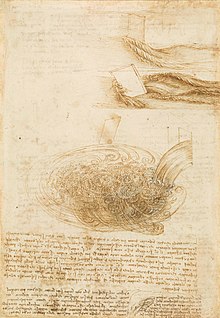
Back Stromingsleer Afrikaans ميكانيكا الموائع Arabic Mecánica de fluyíos AST Hidroaeromexanika Azerbaijani Гідрааэрамеханіка Byelorussian Механика на флуидите Bulgarian প্রবাহী বলবিজ্ঞান Bengali/Bangla Mehanika fluida BS Mecànica dels fluids Catalan Mechanika tekutin Czech

| Continuum mechanics |
|---|
Fluid mechanics is the study of how fluids move and the forces on them.[1][2][3][4] (Fluids include liquids and gases.)
Fluid mechanics can be divided into fluid statics, the study of fluids at rest, and fluid dynamics,[5] the study of fluids in motion. It is a branch of continuum mechanics, a subject which models matter without using the information that it is made out of atoms.[6][7][8][9][10]
The study of fluid mechanics goes back at least to the days of ancient Greece, when Archimedes made a beginning on fluid statics. However, fluid mechanics, especially fluid dynamics, is an active field of research with many unsolved or partly solved problems. Fluid mechanics can be mathematically complex. Sometimes it can best be solved by numerical analysis, typically using computers. A modern discipline, called Computational Fluid Dynamics (CFD), is devoted to this approach to solving fluid mechanics problems.[11][12][13][14][15]
- ↑ Munson, B. R., Okiishi, T. H., Huebsch, W. W., & Rothmayer, A. P. (2013). Fluid mechanics (p. 147). Singapore: Wiley.
- ↑ Fay, J. A. (1994). Introduction to fluid mechanics. MIT press.
- ↑ Elger, D. F., Roberson, J. A., Williams, B. C., & Crowe, C. T. (2016). Engineering fluid mechanics (Vol. 7). Hoboken (NJ): Wiley.
- ↑ Vennard, J. K. (2011). Elementary fluid mechanics. Read Books Ltd.
- ↑ Batchelor, C. K., & Batchelor, G. K. (2000). An introduction to fluid dynamics. Cambridge University Press.
- ↑ Spencer, A. J. M. (2004). Continuum mechanics. Courier Corporation.
- ↑ Lai, W. M., Rubin, D. H., Krempl, E., & Rubin, D. (2009). Introduction to continuum mechanics. Butterworth-Heinemann.
- ↑ Gurtin, M. E. (1982). An introduction to continuum mechanics. Academic Press.
- ↑ Mase, G. T., Smelser, R. E., & Rossmann, J. S. (2020). Continuum mechanics for engineers. CRC Press.
- ↑ Liu, I. S. (2013). Continuum mechanics. Springer Science & Business Media.
- ↑ Anderson, J. D., & Wendt, J. (1995). Computational fluid dynamics (Vol. 206). New York: McGraw-Hill.
- ↑ Chung, T. J. (2010). Computational fluid dynamics. Cambridge University Press.
- ↑ Blazek, J. (2015). Computational fluid dynamics: principles and applications. Butterworth-Heinemann.
- ↑ Wesseling, P. (2009). Principles of computational fluid dynamics (Vol. 29). Springer Science & Business Media.
- ↑ Anderson, D., Tannehill, J. C., & Pletcher, R. H. (2016). Computational fluid mechanics and heat transfer. Taylor & Francis.